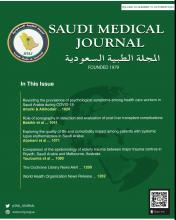Systematic Review
Revisiting the prevalence of psychological symptoms among health care workers in Saudi Arabia during COVID-19
Alturki & Alkhodair analyze the existing literature on the prevalence of psychological symptoms in healthcare workers (HCWs) in Saudi Arabia during the COVID-19 pandemic. The review evaluates the assessment methods used for measuring the prevalence of psychological symptoms and critically review the literature’s findings concerning psychological support for HCWs. The articles are screened following the preferred reporting items for systematic reviews and meta-analyses protocol. Assessment of the quality and risk of bias in the included studies is guided using the prevalence critical appraisal tool criteria. They concluded that this review’s findings provide valuable insights into the psychological symptoms experienced by HCWs during the pandemic. To ensure the consistency of the results, it is essential to reevaluate the prevalence of these symptoms and use a culturally sensitive approach to translating the measures. This review lays the groundwork for future research on psychological symptoms and the interpretation of measurement outcomes.
see page 1020
Preferred reporting items for systematic reviews and meta-analyses flow diagram of the study selection process.
Original Articles
Role of sonography in detection and evaluation of post liver transplant complications
Babikir et al evaluate the role of sonography in revealing and characterizing liver transplant complications based on gray scale and color Doppler and discuss the significance of distinguishing normal transient changes in the spectral waveform from findings that may suggests ominous complications. They carry out a retrospective cross-sectional study at Prince Sultan Military Medical City, Riyadh, Saudi Arabia. Their results show that most patients are males with the most frequent age group being those between 54-71 years. Hepatitis B virus and hepatic cellular carcinoma are the most common indications for transplants. A total of 95 patients received a graft from a living related donor. Regarding complications, biliary issues are the second most frequent complication after collections. Vascular complications represents 7.4% of all complications and is the leading cause of death in 4.8% of cases. Among all vascular issues encountered during liver transplant, portal vein thrombosis is the most predominant. They concluded that ultrasound plays a crucial role in the post-operative management of compilations, facilitating early detection, which is substantial for the graft survival.
see page 1041
Frequency distribution of the overall complications.
Exploring the quality of life and comorbidity impact among patients with systemic lupus erythematosus in Saudi Arabia
Aljohani et al explore the quality of life (QoL) of patients with systemic lupus erythematosus (SLE) and the factors affecting it. In this cross-sectional study, 269 patients diagnosed with SLE from multiple centers across different regions of Saudi Arabia were included. They use the LupusPRO1.8 QoL assessment tool. The overall mean QoL score is 57.71±11.97, with the median value (interquartile range [IQR]) of 56.82 (48.62-66.65). The mean health-related QoL (HRQoL) score is 57.09±18.81, with the median (IQR) of 55.63 (44.04-70.19). Among HRQoL domains, the emotional health domain has the lowest score (44.67±30.00, median: 41.7 [16.7-66.7]). Regarding non-HRQoL, the mean score is 58.32±15.52 and median (IQR) score is 58.85 (48.18-70.83). The desires-goals domain has the lowest score (45.79±31.41), with the median value of 43.8 (21.9-68.8). The presence of comorbidities is the only factor affecting the QoL of patients with SLE. They concluded that their findings indicate that patients with SLE have worse overall QoL, which includes both HRQoL and non-HRQoL domains. Furthermore, the presence of comorbidities was the only factor that influenced the QoL of lupus patients.
see page 1071
The prevalence of non-systemic lupus erythematosus related chronic diseases among systemic lupus erythematosus patients.
Comparison of the epidemiology of elderly trauma between major trauma centres in Riyadh, Saudi Arabia and Melbourne, Australia
Touloumis et al review the epidemiology of elderly trauma at the Kind Saud Medical City (KSMC), Riyadh, Saudi Arabia, and carry out risk-adjusted analyses to benchmark outcomes with the Alfred Hospital, Melbourne, Australia, the largest Australasian trauma service. This retrospective study includes records of injured patients (≥65 years) from the hospital trauma registries during 2022. Demographic and injury data were extracted. Risk-adjusted endpoints are: inpatient mortality and length of stay, analysed using logistic and median regression. The modal injury group is low level falls in both centres (≈60%). Discharge destination is different, particularly for patients discharged home (86.5% vs. 56%) or to a rehabilitation facility (0.5% vs. 28.2%). The risk-adjusted length of stay is 4.5 days less at the Alfred Hospital (95% CI: [3.25-5.77] days, p<0.001). The odds of in-hospital death are not significantly different (OR=0.72, 95% CI: [0.36-1.47], p=0.37). They concluded that despite the different settings, low level falls were the major cause of injury in older patients. A longer length of stay in the acute hospital was identified for KSMC, however, this may be partly explained by discharge destination practices in the 2 countries.
see page 1080
- Copyright: © Saudi Medical Journal
This is an Open Access journal and articles published are distributed under the terms of the Creative Commons Attribution-NonCommercial License (CC BY-NC). Readers may copy, distribute, and display the work for non-commercial purposes with the proper citation of the original work.









